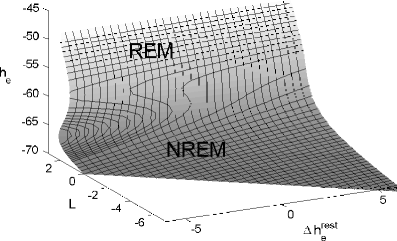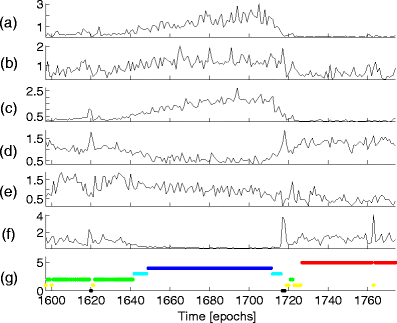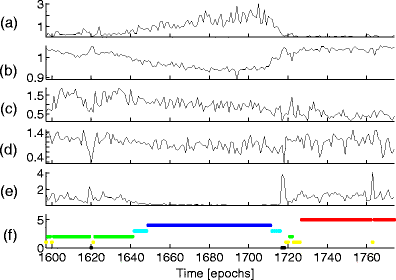A continuous mapping of sleep states through association of EEG with a mesoscale cortical model
- PMID: 20809258
- PMCID: PMC3058368
- DOI: 10.1007/s10827-010-0272-1
A continuous mapping of sleep states through association of EEG with a mesoscale cortical model
Abstract
Here we show that a mathematical model of the human sleep cycle can be used to obtain a detailed description of electroencephalogram (EEG) sleep stages, and we discuss how this analysis may aid in the prediction and prevention of seizures during sleep. The association between EEG data and the cortical model is found via locally linear embedding (LLE), a method of dimensionality reduction. We first show that LLE can distinguish between traditional sleep stages when applied to EEG data. It reliably separates REM and non-REM sleep and maps the EEG data to a low-dimensional output space where the sleep state changes smoothly over time. We also incorporate the concept of strongly connected components and use this as a method of automatic outlier rejection for EEG data. Then, by using LLE on a hybrid data set containing both sleep EEG and signals generated from the mesoscale cortical model, we quantify the relationship between the data and the mathematical model. This enables us to take any sample of sleep EEG data and associate it with a position among the continuous range of sleep states provided by the model; we can thus infer a trajectory of states as the subject sleeps. Lastly, we show that this method gives consistent results for various subjects over a full night of sleep and can be done in real time.
Figures












Similar articles
-
A probabilistic framework for a physiological representation of dynamically evolving sleep state.J Comput Neurosci. 2014 Aug;37(1):105-24. doi: 10.1007/s10827-013-0489-x. Epub 2013 Dec 22. J Comput Neurosci. 2014. PMID: 24363031
-
Cortical development, electroencephalogram rhythms, and the sleep/wake cycle.Biol Psychiatry. 2015 Jun 15;77(12):1071-8. doi: 10.1016/j.biopsych.2014.12.017. Epub 2014 Dec 24. Biol Psychiatry. 2015. PMID: 25680672 Free PMC article. Review.
-
Nonlinear dynamical analysis of the neonatal EEG time series: the relationship between sleep state and complexity.Clin Neurophysiol. 2008 Aug;119(8):1812-1823. doi: 10.1016/j.clinph.2008.03.024. Epub 2008 May 16. Clin Neurophysiol. 2008. PMID: 18486543
-
Non-linear analysis of the sleep EEG.Psychiatry Clin Neurosci. 1999 Apr;53(2):159-61. doi: 10.1046/j.1440-1819.1999.00540.x. Psychiatry Clin Neurosci. 1999. PMID: 10459677
-
Cortical mechanisms of loss of consciousness: insight from TMS/EEG studies.Arch Ital Biol. 2012 Jun-Sep;150(2-3):44-55. doi: 10.4449/aib.v150i2.1361. Arch Ital Biol. 2012. PMID: 23165870 Review.
Cited by
-
A probabilistic framework for a physiological representation of dynamically evolving sleep state.J Comput Neurosci. 2014 Aug;37(1):105-24. doi: 10.1007/s10827-013-0489-x. Epub 2013 Dec 22. J Comput Neurosci. 2014. PMID: 24363031
-
Inter-hemispheric oscillations in human sleep.PLoS One. 2012;7(11):e48660. doi: 10.1371/journal.pone.0048660. Epub 2012 Nov 7. PLoS One. 2012. PMID: 23144920 Free PMC article.
-
Human seizures couple across spatial scales through travelling wave dynamics.Nat Commun. 2017 Apr 4;8:14896. doi: 10.1038/ncomms14896. Nat Commun. 2017. PMID: 28374740 Free PMC article.
-
A probabilistic method for determining cortical dynamics during seizures.J Comput Neurosci. 2015 Jun;38(3):559-75. doi: 10.1007/s10827-015-0554-8. Epub 2015 Apr 8. J Comput Neurosci. 2015. PMID: 25851500
-
Transient neocortical gamma oscillations induced by neuronal response modulation.J Comput Neurosci. 2020 Feb;48(1):103-122. doi: 10.1007/s10827-019-00738-0. Epub 2020 Jan 28. J Comput Neurosci. 2020. PMID: 31989403
References
-
- Ataee, P., Yazdani, A., Setarehdan, S. K., & Noubari, H. A. (2007). Manifold learning applied on EEG signal of the epileptic patients for detection of normal and pre-seizure states. In Proceedings of the 29th Annual International Conference of the IEEE EMBS (pp. 5489–5492). - PubMed
-
- Bojak, I., & Liley, D. T. (2005). Modeling the effects of anesthesia on the electroencephalogram. Physical Review E, 71(041902). - PubMed
-
- Corsi-Cabrera M, Guevara MA, Río-Portilla YD, Arce C, Villanueva-Hernández Y. EEG bands during wakefulness, slow-wave and paradoxical sleep as a result of principal component analysis in man. SLEEP. 2000;23(6):1–7. - PubMed
Publication types
MeSH terms
LinkOut - more resources
Full Text Sources
Other Literature Sources

